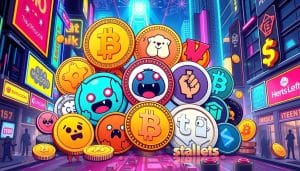Did you know that Solana can process transactions way faster than Ethereum, even with fewer validators? Ethereum has over a million validators, highlighting its strong network. However, Solana, with just 1,576 validators, completes transactions hundreds of times quicker. It can finish a transaction in just 5 seconds, unlike Ethereum’s ~15 minutes. Plus, Solana’s cost per transaction is only $0.0221 USD, way cheaper than Ethereum’s $8.93 USD. This battle for blockchain supremacy is heating up between Solana and Ethereum.
Ethereum revolutionized the tech world with smart contracts and dApps, creating a huge DeFi ecosystem. Yet, it struggles with slow transaction speeds. Solana uses Proof of History (PoH) and Proof of Stake (PoS) for faster and cheaper transactions. This makes it a great alternative. Currently, 65.7% of Solana’s tokens are staked, showing users trust it. Solana is working on solving the blockchain trilemma: scalability, security, and decentralization. Its efforts could potentially make it surpass Ethereum by 2024.
Table of Contents
ToggleKey Takeaways
- Ethereum has over 1,049,295 validators showing high decentralization1.
- Solana finalizes transactions in 5 seconds, with a minimal gas fee of $0.0221 USD1.
- Solana utilizes PoH and PoS mechanisms to enhance throughput and scalability2.
- 65.7% of Solana’s circulating tokens are currently staked, reflecting user confidence1.
- Solana processes thousands of transactions per second, significantly outpacing Ethereum’s ~153.
Introduction to Solana and Ethereum
Solana and Ethereum stand tall in the world of blockchain, offering unique solutions. Ethereum brought us smart contracts and dApps in 2015. In 2017, Solana focused on quick transactions and low costs.
Overview of Their Technological Foundations
Ethereum changed the game with smart contracts, starting the DeFi movement4. It uses Solidity, a complete language for dApps. Yet, its old Proof-of-Work system limited its speed, pushing for a shift to Proof-of-Stake to hit 100,000 TPS5.
On the other hand, Solana combines Proof of History with PoS for fast speeds, reaching up to 65,000 TPS at low costs4. This setup tackles the scalability problems seen in Ethereum4.
The Current State of Blockchain Dominance
Ethereum, despite its big impact and $404.36 billion value, still fights scalability issues and network delays564. Users and developers worry about high fees during busy times4.
Contrastingly, Solana’s value is climbing, now at $78 billion, thanks to its SOL token6. It boasts 1,700 validators and minimal fees, making it an attractive choice for many6. This growth and its strong tech suggest it might soon rival Ethereum’s lead4
The Evolution of the Solana Blockchain
Solana started with its Initial Coin Offering (ICO) in 2020 and quickly got everyone’s attention. It promised fast and powerful apps without using a central server. Solana’s price went up a lot in 2021 and then went down in 2022 due to market troubles and big events like the FTX collapse. But by the end of 2023, Solana had made a strong comeback.
Initial Coin Offering and Early Performance
The Solana ICO in 2020 was a big deal because it set high goals for how the blockchain would work. People who got in early were excited by how fast Solana could go and how little it cost to use it. Solana locked up more than 70% of its SOL cryptocurrency, making the network safe and spread out7. But, most of the control was still in the hands of the top 20 stakers, raising some worries8.
The Unique Consensus Mechanisms: PoH and PoS
Solana is special because of its Proof of History (PoH) and Proof of Stake (PoS) ways of keeping track of transactions. PoH lets Solana put time stamps on transactions, which makes checking them fast and lets it handle a lot8. This combo lets Solana handle up to 50,000 transactions every second8. This is much more than Ethereum, which can’t do as much because of its older system7.
Developer and User Adoption
More developers are using Solana because of its Sealevel system. This system runs contracts at the same time, making things go faster. Solana’s fast and cheap transactions pull in developers7. It’s also great for users. Transactions are done in less than half a second and cost less than a hundredth of a penny7. Solana’s Turbine protocol sends data fast all over the world, making things even quicker7.
| Aspect | Solana | Ethereum |
|---|---|---|
| Transactions Per Second | 50,000 | 15 |
| Transaction Finality Time | ~12-14 seconds | |
| Transaction Fees | ~$0.05 – $15 |
Solana focuses on being fast, safe, and able to handle lots of work. It wants to be better than Ethereum by 20247. Solana keeps getting better and adding new features. It’s ready to take the lead and attract lots of users and developers, even those who have been with Ethereum for a long time.
Comparing Solana vs. Ethereum
Ethereum leads in smart contract execution with its Solidity language. It allows for complex decentralized apps9. Solana uses Rust and C for fast and efficient smart contracts9. It also lets developers move from Ethereum easily thanks to SPL and Solidity compatibility.
Smart Contract Capabilities
Ethereum’s tools like Truffle Suite and MetaMask help its blockchain grow9. On the flip side, Solana provides the Anchor Framework9. This framework eases the development of smart contracts, aiding Solana’s ecosystem growth.
Transaction Speed and Costs
Solana processes over 50,000 transactions per second (TPS), far outdoing Ethereum’s 15-45 TPS9. Its design allows for fast transactions with nearly no wait9. Solana’s transactions cost about 0.0001 SOL, cheaper than Ethereum’s fees of 18.45 Gwei in April 20249. High Ethereum costs during the DeFi boom made it expensive for small transactions10.
Market Capitalization and User Base
Ethereum stands tall with a cryptocurrency market cap over $250 billion. Yet, Solana’s $35 billion cap shows its growing popularity11. With 940k+ daily users and more transactions, Solana is growing faster than Ethereum11. Its affordability and scalability attract more users.
Solana’s technology reduces data storage costs with unique hash values10. This makes Solana more attractive in thecryptocurrency market capand increases its user base.
Ethereum’s Scalability Challenges
Ethereum is a top blockchain platform facing big scalability issues. High network traffic often leads to slow transaction speeds and higher costs during busy times12. At its best, Ethereum can handle about 30 transactions per second. This is much less than its rival Solana, which manages thousands more12.
The Ethereum blockchain struggles because it uses a single-threaded execution model. The Ethereum Virtual Machine (EVM) processes transactions one by one13. This slows down the throughput and makes it hard to support the growing number of decentralized applications (dApps)13. When the network is busy, users often pay high gas fees, which worsens the user experience12.
Ethereum’s state tree is another problem. It has 256 levels and needs a lot of updating, which slows down the network13. The time it takes for blocks to spread also increases the delay in confirming transactions, making network performance worse13.
However, the Ethereum 2.0 upgrade is set to tackle these scalability issues. By moving to a proof-of-stake (PoS) model, it aims to cut energy use, boost transaction speed, and reduce costs12. Ethereum 2.0 is expected to majorly improve the network congestion and make decentralized apps work better on the platform.
The process of syncing the Ethereum blockchain adds extra delay. This is due to block checking, approval, and network syncing13. Every new transaction grows the state size, needing more storage and check time and adding to the scalability challenge13.
All these issues highlight the urgent need for Ethereum 2.0 to work in fixing these bottlenecks. Whether these enhancements will solve the scalability problems and match up to faster, more effective blockchains like Solana, only time will tell.
Solana’s Technological Advantages
Solana shines in the blockchain area with its standout tech perks. It boosts high numbers of blockchain transactions and keeps costs low. It can handle over 65,000 transactions per second (TPS), leaving Ethereum’s 15-45 TPS in the dust1415. This is thanks to its unique design and scaling methods. These methods keep the network fast, even as it grows bigger14.
High Throughput and Low Transaction Fees
Solana’s setup means really low fees for transactions, way lower than Ethereum’s14. This is a big win for both developers and users who don’t want to spend much. Also, with blocks done in just 600 milliseconds, things move quickly15. It’s a solid foundation for new apps, finance projects, and digital art worlds, ranking it high among developers’ choices16.
Developer-Friendly Environment
Solana’s ecosystem is a paradise for developers, thanks to its amazing Solana developer tools14. It’s even set up to work easily with Ethereum projects. This makes moving projects over a breeze, helping developers use what they already know16. Solana’s wide range of tools is pulling in more developers, sparking creativity in fields like finance, digital art, and games14.
| Blockchain | Transaction Throughput (TPS) | Average Transaction Fees |
|---|---|---|
| Solana | 65,000 | $0.00025 |
| Ethereum | 15-45 | Variable |
| Bitcoin | 3-7 | Variable |
Solana is a strong player in the blockchain game, bringing advanced solutions for our digital needs. Its combo of low costs and quick transactions fits perfectly with the digital era. It’s pushing the boundaries of what blockchain tech can do.
Recent Solana Network Updates
Solana has made big improvements to its blockchain network. These updates aim to boost its overall performance.
Firedancer Validator and Its Impact
The Solana network introduced the Firedancer validator client. This client could handle up to 1 million transactions every second. It’s set to greatly improve Solana’s network performance, making it a strong competitor to Ethereum17.
The Firedancer validator client also helps with network congestion and makes transactions more efficient. It uses advanced technology to reduce issues from bot trading seen in April 202418. A new feature compresses transactions using cutting-edge security, making account management more efficient18.
Thanks to these updates, Solana’s network can handle more transactions, offering a reliable and efficient platform. This led to a huge increase in Solana’s daily transactions, reaching over $1 trillion in January 202417.
Market Performance and Price Forecast
Solana has seen a lot of ups and downs in the crypto market. Its prices have followed the overall market trends.
Historical Price Trends
In 2021, Solana hit a high point, thanks to investor excitement and its tech performance. But, the market downturn and the FTX crash led to a fall. This shows how unpredictable crypto investments can be. Solana manages 400 transactions per second (TPS) on average, with peaks over 2,000 TPS19. This is much better than Ethereum’s 12 TPS and Bitcoin’s 7 TPS.
Future Projections for SOL
The future looks bright for SOL, thanks to network fixes and new strategies. Solana’s transaction fees are under $0.001. This is way cheaper than Bitcoin and Ethereum, with their high fees19. Solana has 1,893 active validators and 925 RPC nodes as of July 202319. It’s working to reach over 100M users and aims for a 20% monetization rate. By 2030, it hopes to make $8B20.
Solana plans to boost its data handling by ten times with the Firedancer upgrade20. These improvements could make Solana a top choice for investing in crypto.
The Role of Decentralized Finance (DeFi) on Solana
Solana is moving forward fast in the decentralized finance area thanks to its strong tech. It offers high-speed transactions and low fees. This makes it very appealing for both people making apps and those using them.
Key DeFi Protocols on Solana
On Solana, several important DeFi protocols are making a difference due to its speed and power. Projects like Serum stand out as a decentralized exchange with lots of liquidity and cheap transactions. Raydium is known for its great swap prices and pools. Solend helps with easy borrowing and lending of assets21.
In addition, Solana hosts innovative solutions like Orderbook DEXs, Prediction Markets, and Dynamic NFTs. Its advanced features, like Proof of History and Sealevel Smart Contracts, make this possible22.
Advantages Over Ethereum in DeFi
Solana has a big advantage over Ethereum in terms of transaction speed and cost. It can handle over 50,000 transactions each second and has very short block times2122. Also, the fees are extremely low, even as little as $0.00025 per transaction, making it a cost-effective choice2122. While Ethereum faces issues with scalability and high fees, Solana offers a smoother and cheaper alternative for DeFi projects.
DeFi aggregators like Sunny and Apricot Finance play an important role on Solana by boosting yields from various protocols22. Thanks to partnerships with big names like Stripe and Circle, Solana is set up for speedy USDC payments and a safe trading space21.
Proof-of-Stake Blockchain Comparison
When we compare proof-of-stake blockchains, both Solana and Ethereum stand out. They are moving towards a consensus system with better energy efficiency and lower environmental impact. Solana uses a proof-of-stake consensus that includes Byzantine Fault Tolerance. This reduces latency and increases security by involving many stakeholders financially23. Solana’s approach aims to cut blockchain energy use while keeping the network secure.
Ethereum is switching from Proof of Work (PoW) to proof-of-stake to address energy concerns24. Solana has always used a PoS system along with Proof of History (PoH). PoH cryptographically records the time between events. This makes Solana’s blockchain more efficient, handling up to 65,000 transactions per second23. It’s even 2.5 times faster than Visa23.
Solana’s PoS system can handle many transactions at low fees, often just cents. In contrast, Ethereum’s fees are usually higher24. This efficiency reduces both energy consumption and environmental impact.
In the DeFi area, Solana is known for projects like Serum, Raydium, and Mango Markets24. Ethereum leads with Uniswap, MakerDAO, and Compound24. Despite Ethereum’s large developer community, Solana’s lower costs and faster transactions are appealing. Solana looks to enhance its technology and market presence continually24.
Both chains are part of a shift towards more sustainable and efficient blockchain solutions. By adopting proof-of-stake and unique mechanisms, Solana and Ethereum are creating a future of greener and more robust blockchains.
Discover the future potential of Solana here.
Solana’s Strategic Partnerships and Collaborations
Solana has rapidly become a key player in blockchain, thanks to its strategic collaborations. Its powerful technology lets it handle thousands of transactions every second, all at low cost. This makes it an attractive option for developers and users25. Besides, Solana stands out by supporting fast, scalable processing.
One of its biggest moves is teaming up with Google Cloud. Together, they’re setting up a Solana validator that will start in 202326. This enhances Solana’s tech infrastructure and shows its dedication to innovation. Additionally, a partnership with Mastercard is on the horizon, promising to boost trust in digital currencies26.
Solana has attracted investments from 39 big names like Andreessen Horowitz and Coinbase Ventures26. These investments show the faith in Solana’s future and strengthen its role in blockchain partnerships. The ecosystem rewards its supporters with things like more SOL tokens and technical help, building a lively community25.
Solana is also working on making it easier for different blockchain networks to work together. This encourages more innovation and growth25. By supporting Solidity, it welcomes Ethereum projects to its platform, promising speed and lower costs25. Solana’s strong relationships in the industry pave the way for ongoing expansion.
| Partnership or Collaboration | Impact on Solana Ecosystem |
|---|---|
| Google Cloud | Enables users to launch dedicated Solana nodes in the Cloud |
| Mastercard | Develops new standards to enhance trust in cryptocurrencies |
| Andreessen Horowitz and Others | Secured investments to bolster Solana’s innovative technology |
User and Developer Experience on Solana
Solana brings an impressive set of features that boost the experience for both users and developers. It is EVM compatible, making it easy for folks to move from Ethereum to Solana. This feature allows for a smooth jump to a faster ecosystem. The Solana blockchain can handle up to 4000 transactions every second. This speed means users don’t face the slow delays seen on other platforms27.
EVM Compatibility
Solana’s ability to work with the Ethereum Virtual Machine (EVM) attracts many blockchain developers. Moving projects from Ethereum to Solana is easier because of this. Solana offers a scalable and energy-saving alternative to Ethereum’s busy network28. This compatibility encourages a space where developers can use Solana’s top-notch features and fast transactions.
Developer Tools and Resources
Solana’s developer scene is filled with resources and tools for efficient development. It supports languages like Rust, C++, and C for powerful smart contract creation27. The Solana toolkit and command-line interface make setting up a development environment easy. These tools support local building and testing of Solana programs, making development simpler29.
Frameworks such as Seahorse and Anchor add layers that make developing Solana applications in Rust and Python easier. This boosts developer productivity29. Experienced developers play a key role in setting architectures, mentoring, and code reviews. This ensures solid support for developers29. Plus, a Solana developer can earn about $115,000, which is very attractive29.
The Impact of NFT Market on Solana vs. Ethereum
In the growing NFT world, Solana and Ethereum are big competitors, focusing on the number of NFTs created and marketplace growth. Over the past month, Solana made a whopping 32 million NFTs, far outpacing Ethereum’s 1 million. This shows that Solana can handle lots of transactions smoothly3031. Its lower costs also make it an attractive option for those making and trading NFTs, setting it apart in the market.
Yet, Ethereum still tops in NFT sales, with $193 million against Solana’s $99 million. This shows the market’s trust in Ethereum’s environment3031. Ethereum’s reputation and wide-ranging ecosystem play a big role in its leading position.
Solana draws in users with its speed and low-cost transactions, crucial for digital art and games30. Solana’s positive price trend shows growing investor interest31. Plus, Solana’s enthusiastic community is a driving force behind its quick rise in the NFT world, showing the power of user engagement3031.
Solana supports cool and new projects like STEPN, SMB Gen2, and Mad Labs, benefiting from its quick and cheap transactions. These projects range from fitness to digital collectibles30. Ethereum, with projects like y00ts and DeGods, grabs attention with unique art and strong community ties30.
Choosing between Solana and Ethereum for NFT development shows that both have their strengths. Solana’s ability to handle up to 65,000 transactions per second makes it a promising choice for future digital art and gaming projects, compared to Ethereum’s 15-30 TPS32.
| Metric | Solana | Ethereum |
|---|---|---|
| NFTs Minted in 30 Days | 32 Million3031 | 1 Million3031 |
| NFT Sales Volume (30 Days) | $99 Million3031 | $193 Million3031 |
| Transaction Speed | Up to 65,000 TPS32 | 15-30 TPS32 |
| Gas Fees | Approximately 0.0001 SOL32 | Upwards of $132 |
Solana’s Market Potential in the United States
In the USA, blockchain is becoming very popular. This means Solana has a huge chance to grow. It’s super fast, able to handle up to 65,000 transactions every second33. This speed, along with recent successes, makes Solana a top pick for big investments in the US crypto world34.
Solana’s price journey is quite a story. Starting at just $0.50 in March 2020, it jumped to a peak of $258.93 by November 202133. Even after a drop in 2022, it’s now at $152.86, showing it’s bouncing back well3534. This bounce-back highlights investor trust in its future.
Solana stands out because it processes lots fast and doesn’t charge much for transactions. That’s great for decentralized exchanges, NFTs, and stablecoins, challenging even Ethereum35. For investors, putting money into Solana could be very rewarding. It’s catching the eye of both developers and users.
Solana is now among the top five cryptocurrencies worldwide35. Predictions say SOL could hit $200-$250 by end of 2024 and maybe even over $300 by 2025. That makes it a tempting option for US crypto investors3334.
The strategic success of Solana is tied to its ability to maintain a balance between scalability, security, and decentralization in the dynamically evolving blockchain market.
Solana is growing by making smart partnerships and innovating in the US crypto market. This could make its position even stronger. As it keeps developing, Solana is seen as a big opportunity for investors.
| Statistic | Solana | Ethereum |
|---|---|---|
| Transactions per Second | 65,000 | 30 |
| All-Time High (USD) | $260 | $4,891 |
| Current Price (August 2024, USD) | $152.86 | $1,817.23 |
| Market Capitalization (USD Billion) | $71.60 | $557.47 |
The Future of Blockchain Scalability
The future of blockchain scalability looks bright with big changes ahead. Trends in the blockchain field are heading towards more streamlined and scalable options. This means things will get a lot better for users. Solana is a standout because it can manage thousands of transactions every second. It does this while keeping costs low. This is thanks to its mix of Proof of History and Proof of Stake mechanisms3637. Because of this, Solana is an exciting choice for developers looking at 2024 and beyond.
Predictions for 2024
Solana’s solutions for scalability are already bringing in more users. This trend is expected to keep going until 2024. Solana started in 2020 and has grown quickly. It can meet high demand with great speed and affordability37. Many developers prefer Solana for its trending solutions in the blockchain space. Its simple design and cheap transaction costs draw in more projects. This suggests that it will continue to grow.
Potential Innovations and Upgrades
In 2024, we’ll see many new features and improvements that will strengthen Solana’s role in the blockchain world. Being able to handle lots of transactions with low fees is a big draw for digital asset trading on the platform36. The introduction of the Firedancer validator is expected to improve Solana’s system, helping it perform well. Solana’s design is also energy-wise, which makes it attractive in an eco-friendly market37.
The growth of decentralized applications and strong backing from the Solana community promise to bring in more users37. As the blockchain field grows, Solana’s setup could serve as an example for how to scale effectively. This places it as a major figure for blockchain forecasts in 2024.
| Factors | Solana | Ethereum |
|---|---|---|
| Transaction Speed | Thousands per second37 | Around 30 per second |
| Transaction Costs | Low even under high demand37 | Can rise significantly under load |
| Energy Efficiency | Highly energy-efficient37 | Moderate to high consumption |
| Adoption and Ecosystem Growth | Rapidly growing with various projects37 | Established but slower growth |
Solana Blockchain Scalability
Solana’s scalability has greatly improved network performance. It’s perfect for those needing an efficient, scalable blockchain solution. It can handle up to 50,000 transactions per second, thanks to its Gulf Stream Protocol and PoH. These technologies ensure fast and efficient order of transactions, boosting app performance38. Interestingly, Solana might reach a throughput of 28.4 million TPS on certain infrastructure38.
The Solana network features a Pipeline system for quick validation and duplication of transaction data38. This not only speeds up transactions but also supports various apps effectively. Its upgrades are in high demand for this reason38. Additionally, the Turbine protocol aids in quick block transmission by breaking blocks into smaller packets. This means Validator nodes can share data more efficiently39.
Solana’s scalability capabilities include a mean transaction time of 2.34 seconds40. This quick processing paired with the ability to handle up to 47,370 TPS sets Solana apart in blockchain technology40. It’s enabling diverse applications, from finance to gaming, to perform better than ever40.

Solana’s Pipeline feature can process transactions incredibly fast, getting confirmations in under a second39. This efficiency makes the blockchain highly scalable, performing well even under heavy loads. Plus, the Gulf Stream protocol eliminates the mempool need, processing up to 100,000 transactions swiftly. This drastically cuts down on memory use and speeds up confirmations39.
In summation, Solana showcases its scalability through innovation like PoH, the Gulf Stream protocol, and the Pipeline system. These advancements allow for smooth, efficient app performance. Solana’s technology is setting new standards for a fast, reliable blockchain experience39.
Conclusion
In our detailed look at blockchain technology, we see Solana and Ethereum are more than just competitors. They’re pushing the boundaries with new ideas and ways to win over the market. Solana stands out with its advanced systems. It can handle way more transactions every second than Ethereum. This makes Solana faster and able to grow bigger, quicker41. Plus, its lower fees bring in more users and developers, putting it up there with the best in blockchain42.
Solana’s tech breakthroughs, like its special way of reaching agreement in the network and making it easy for developers, put it right up against Ethereum41. It offers fast transactions and places to buy and sell digital art cheaply and quickly, like Solanart and Metaplex. This appeals to those creating or collecting digital art41. Even though some question how spread out Solana’s control is, its stellar performance and focus on what users want keep drawing in more projects and use cases41.
The fight between Solana and Ethereum will influence what comes next in decentralized tech. What users prefer, especially for speedy and expandable options, will help decide the top blockchain. Ethereum has a strong community, but Solana’s improvements offer a tough challenge. This could secure its spot in blockchain’s future42. The blockchain world’s growth will depend on the choices of both users and developers among these innovative platforms42.






















